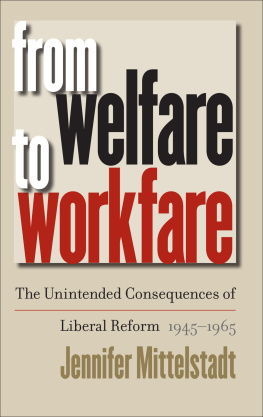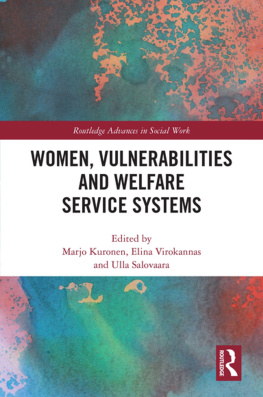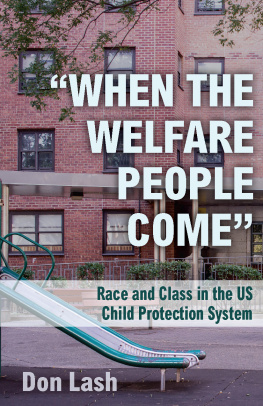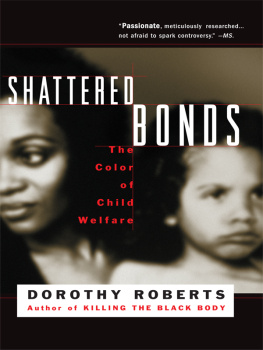System Kids
This book was published with the assistance of the Authors Fund of the University of North Carolina Press.
2015 The University of North Carolina Press
All rights reserved
Set in Utopia and Aller types by codeMantra
Manufactured in the United States of America
The paper in this book meets the guidelines for permanence and durability of the Committee on Production Guidelines for Book Longevity of the Council on Library Resources. The University of North Carolina Press has been a member of the Green Press Initiative since 2003.
Jacket illustration: Photograph of street mural by Geoff Andruik, www.geoffandruik.com.
Library of Congress Cataloging-in-Publication Data
Silver, Lauren J.
System kids : adolescent mothers and the politics of regulation / Lauren J. Silver.
pages cm
Includes bibliographical references and index.
ISBN 978-1-4696-2259-0 (pbk : alk. paper) ISBN 978-1-4696-2260-6 (ebook)
1. Teenage mothersUnited States. 2. Child welfareUnited States. 3. Aid to families with dependent children programsUnited States. 4. Maternal and infant welfareUnited States. I. Title.
HQ759.4.S537 2015
362.7874300973dc23
2014031683
Portions of this work have appeared previously, in somewhat different form, as Minding the Gap: Adolescent Mothers Navigate Child Welfare, Social Science Review 82, no. 4 (2008): 61538, and Spaces of Encounter: Public Bureaucracy and the Making of Child Identities, Ethos 38, no. 3 (2010): 27596.
Dedicated to those who have generously shared their stories
Contents
INTRODUCTION They Want to See You Fail
Dilemmas in Child Welfare
1 Playing Case Manager
Work Life in a Culture of Fear
2 The Better Places Dont Want Teen Moms
Invisible Lives, Hidden Program Spaces
3 The Real Responsibility Is on You!
The Self-Sufficiency Trap
4 I Am Young. Im Not Dumb; and Im Not Anxious
Identity Performances as Service Negotiation
5 The Program Allowed Me to Get Pregnant
Everyday Resistance, Dignity, and Fleeting Collectives
Acknowledgments
Your silence will not protect you.Audre Lorde
Many have supported me in the writing of this book. I have often feared whether I would get it right, because I wanted this book to do justice to the youth and providers who shared their experiences with me. Remaining silent, however, was never an option. I am first and foremost thankful to the young moms and service providers who welcomed me into their lives and their homes, shared their stories, and let me accompany them to court, schools, medical clinics, and numerous other sites across their large northeastern city. I learned more from them than they will ever know. Even though I cannot mention any of the participants by their actual names (just as I cannot name the city where they live), their voices are present and unique; they make up the heart and soul of this book. This book stems from their collective visions of hope and persistence against constraints. I am humbled by the openness and generosity of these young women and their families. It was truly an honor to spend time with them and to get to know them. After many years, I continue to be inspired by their courage, integrity, and willingness to share their stories.
Friends often compared the process of writing this book to giving birth, and the gestation has indeed been long. The birth of this book was only possible through the help and support of many people, across several phases of development. I want to thank my advisors who guided me during the earliest research and writing phase: Kathleen Hall, Katherine Schultz, Margaret Beale Spencer, and Vivian Gadsden. I will never forget the hours, days, and months spent with my writing partner, Cheryl Jones-Walker. The glances of encouragement as she sat across the table from me helped me continue writing that next page. For their encouragement and advice more recently, I want to thank my wonderful Rutgers University colleagues Daniel Hart, Susan Miller, Robin Stevens, Lynne Vallone, and especially Daniel Cook, a wonderful mentor, who read and provided feedback on an entire draft of the book. Dan Cook, thank you for the frozen yogurt at that key moment in the process. I owe much appreciation to my brilliant writing group and dear friends whose keen insights motivated me and made this book possible: Elizabeth Davis, Jessica Goldberg, Belinda Haikes, Pamela Mazzeo, and Melissa Yates.
I am incredibly fortunate to have a generous editor, Joseph Parsons, who understands the book on a deep level and respects me as an author. Joes confidence in the project inspired me to take important risks with the manuscript. I am also grateful for his selection of committed readers and for the scholars whose detailed insights helped me to clarify the arguments and the contributions of the book. I am thankful for the efforts of many individuals at UNC Press who made the publication and distribution of this book possible. I appreciate the close copyediting provided by Romaine Perin before my final submission of the manuscript to UNC Press and her heartfelt comments about the books relevance. Romaine reminded me that stories could be meaningful to audiences in powerful ways that we as authors could never foresee.
I want to thank my family and friends whose encouragement provided the loving foundation for me to do this work. They reminded me of three important themes throughout the process of bringing this book to fruition: trust, perseverance, and patience. In particular, I want to thank my mother, Marilyn Silver; my stepfather, Donald Coates; my brother, Justin Silver; my sister-in-law, Jaime Silver; and my dear friends Hanne Harbison, Anna Koopman, Helen Lee, Joanna Lee, Amy Mahlke, Craig Mahlke, Angela McIver, and Gail Wolfe. Finally, I especially want to thank my wife, Rassa Schickel, whose love and belief in the project provided such a force of support and constancy. Thank you, Ra, for your patience, the delicious meals, and keeping our household afloat while I wrote this book.
System Kids
Introduction: They Want to See You Fail
Dilemmas in Child Welfare
Soon after sundown, in the dimly lit front room of her inner-city apartment, eighteen-year-old Maleka told me about registering for nursing school and the challenges she faced with childcare. All the while, Maleka repeatedly swatted at her wall with a towel, keeping the scurrying roaches from making their way down to her two boys, playing on a secondhand couch. The swatting seemed so habitual that I wondered whether this was something she repeated every evening. It did not distract her from our conversation, nor did it bother her two boys, who continued to play.
This simple, disturbing act represents the many extraordinary, but seemingly minor, efforts of young mothers to protect their children. Maleka lived alone with her sons in an apartment leased by a Supervised Independent Living (SIL) program. The local child welfare agency, Children and Youth Services (CYS), funded this program through a government contract and expected SIL to facilitate residential, educational, and social services. In spite of the dangerous environments and bureaucratic obstacles they encountered on entering the child welfare system, young mothers in SIL persevered. I came to know the SIL program and its young families first as a program manager with concrete responsibilities and then later as a researcher who continued to advocate for clients.
Once the child welfare system assumes legal custody of abused or neglected youth, the youth are in care and the government provides for their well-being. How do we understand the care provided, given the circumstances that Maleka and her children and many other young families face? How would an adolescents living alone with her children in dangerous and pest-infested conditions satisfy any parents wishes for his or her childs well-being, let alone meet the legal mandates of the state? How does the state normalize program conditions for these particular children and youth, who simultaneously occupy several categories of disadvantage?







